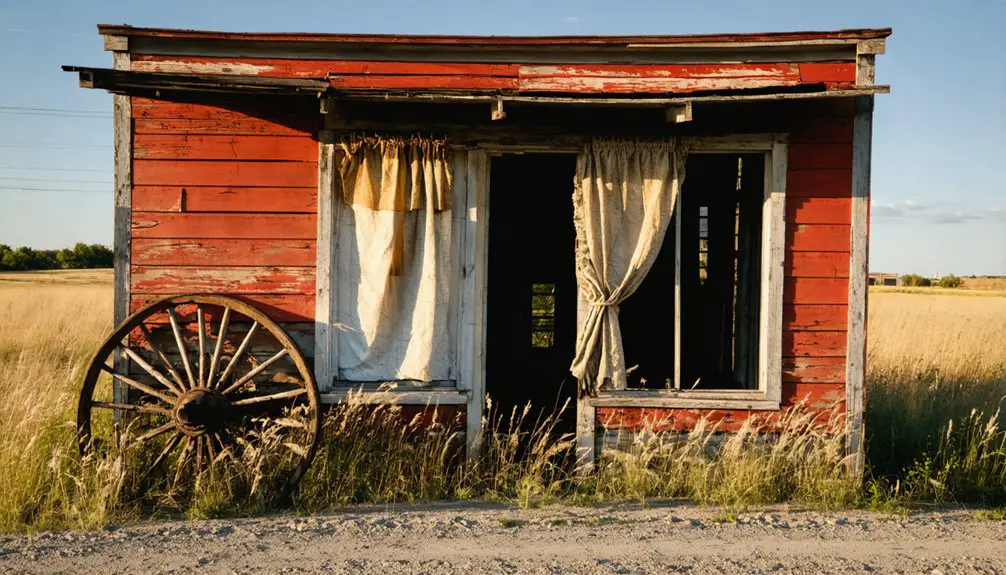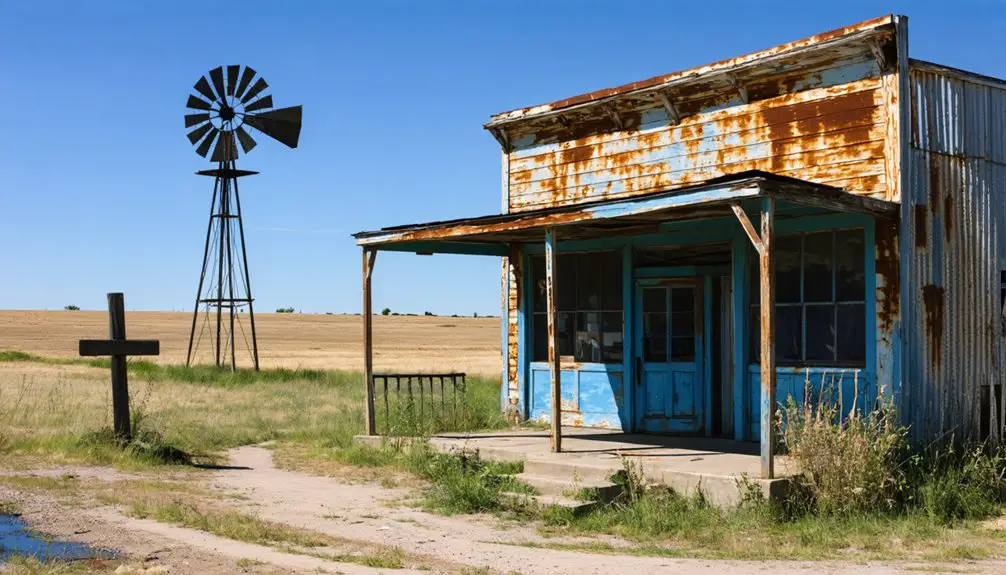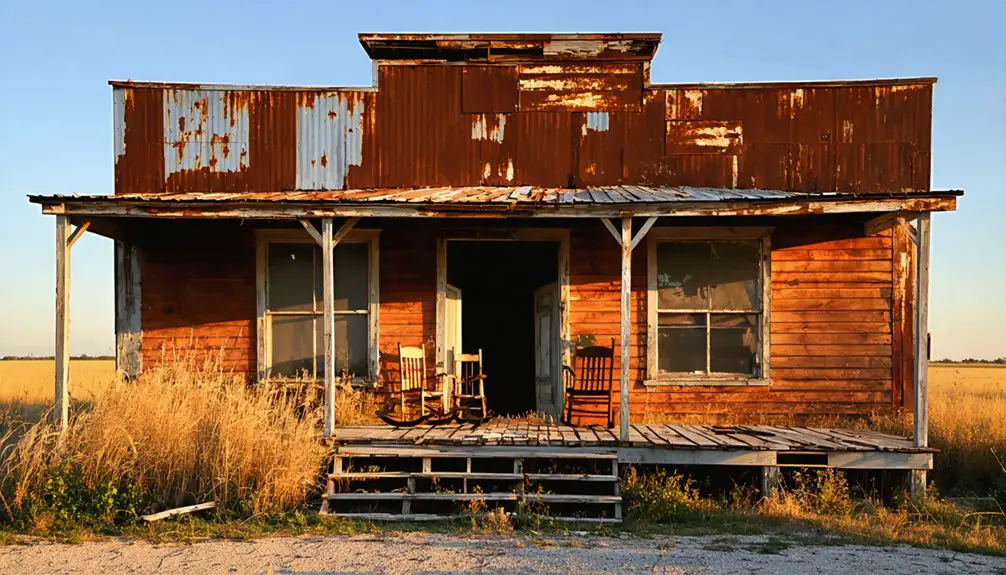You’ll find Perryville’s ghost town remains four miles west of present-day McAlester, Oklahoma. Founded in 1838 by James Perry, this strategic trading post thrived at the intersection of Texas and California Roads, serving as a crucial hub during the Gold Rush era and Civil War period. The town’s decline began in 1872 when the Missouri, Kansas and Texas Railway bypassed it for nearby Bucklucksy (McAlester). Perryville’s ruins hold compelling stories of frontier commerce, military conflict, and territorial transformation.
Key Takeaways
- Perryville was a thriving trading post established between 1838-1840 at the intersection of Texas and California Roads near present-day McAlester.
- The town’s decline began after the Missouri, Kansas and Texas Railway bypassed it in 1872, leading merchants to relocate to McAlester.
- Union forces destroyed Perryville during the Civil War, burning the Confederate supply depot and devastating the town’s infrastructure.
- After its abandonment, Perryville became known as Chambers, Oklahoma, and never recovered its former status as a regional hub.
- The ghost town’s remains serve as evidence of Oklahoma’s frontier period and the impact of changing transportation routes.
The Birth of a Trading Post (1840-1848)
Three key factors converged to establish Perryville as an essential trading post in Indian Territory around 1838-1840.
First, James Perry, a Choctaw-Chickasaw mixed-blood and skilled diplomat, chose its strategic location at the intersection of the Texas and California Roads.
Second, you’ll find it was perfectly positioned just four miles from present-day McAlester, making it an ideal stop for travelers. The establishment of a post office in 1841 further cemented its importance as a regional hub.
Third, the region’s growing need for commerce between Native tribes and settlers demanded such a trading hub. The trading post flourished during the California gold rush as traffic and commerce increased substantially.
Gold Rush Era Prosperity
During the California Gold Rush of 1849, you’d have witnessed Perryville transform into a bustling hub as thousands of westward-bound prospectors stopped to resupply at the trading post’s merchants.
The steady stream of travelers fueled rapid commercial growth, with new businesses like blacksmiths, inns, and supply stores opening to serve both local residents and fortune seekers heading west. Many of these prospectors carried basic panning equipment to test local waterways during their journey.
Perryville’s strategic location along the California Trail enabled merchants to capitalize on the gold rush traffic, which boosted the town’s population and established it as a crucial rest stop between Fort Smith and California. Some travelers shared tales of the Spanish mine workings they had discovered in Oklahoma’s Wichita Mountains while passing through the territory.
Trade Volume Surges
A remarkable surge in trade volume transformed Perryville and the surrounding Oklahoma Territory between 1901-1910, as over two thousand mining claims sparked intense economic activity throughout the region.
You’d have witnessed trade demand skyrocket as thousands of prospectors flooded mining camps, driving the need for tools, food, and services. Mining profitability varied dramatically with ore values ranging from $1 to $600 per ton, creating opportunities for savvy traders. The establishment of six local smelters between 1901 and 1915 further fueled the region’s economic growth.
While Perryville’s growth was eventually limited by the Missouri, Kansas and Texas Railway bypass, you’d have seen the town benefit from its position near Fort Sill and bustling mining communities.
Local merchants supplied both military personnel and miners, while freight movement along established trails kept commerce flowing through this frontier trading post.
California Trail Traffic
While Perryville’s trade boomed locally, the California Trail witnessed an unprecedented movement of humanity that would reshape the American West.
You’d have seen an astounding 250,000 emigrants traverse the trail between 1848 and 1869, with traffic reaching its peak in 1849-1850 when 75,000 people made the journey. The surge transformed California’s population, helping it reach 120,000 residents by 1850. The trail’s popularity helped California achieve admission as a state in 1850. The journey was treacherous, with approximately five percent dying during their westward trek.
As traffic patterns evolved, you’d have noticed emigrant routes diversifying beyond the original trail.
Travelers chose between Donner Pass, Carson Pass, and other alternatives like the Lassen, Nobles, and Beckwourth trails. The network’s expansion proved essential, as it distributed the massive flow of wagons and helped pioneers access various gold fields while reducing congestion on any single path.
Merchant Population Growth
Triggered by the discovery of gold in Oklahoma’s Wichita Mountains, the 1890s brought a surge of commercial activity to Perryville and its surrounding regions.
You’ll find that merchant diversity flourished as indigenous traders, mixed-blood entrepreneurs, and settler merchants established various businesses to serve the influx of miners and their families.
Population stability grew as temporary camps evolved into permanent settlements, with Perryville becoming an essential hub featuring:
- A bustling post office, blacksmith shop, and inn serving regional traffic
- Trading posts capitalizing on increased demand for mining supplies and provisions
- Stage stands facilitating transportation between mining camps and distribution centers
Despite the Missouri-Kansas-Texas Railway’s bypass of Perryville, the town’s merchants adapted to serve the steady stream of prospectors and settlers during the gold rush era.
Military Significance and Strategic Location
Located at the strategic intersection of the Texas Road and California Road, Perryville emerged as a significant military stronghold during the Civil War.
You’ll find its strategic importance evident in its position between Boggy Depot and Skullyville, making it an ideal Confederate supply depot and logistics center. As the county seat of Tobucksy County in Choctaw Nation, it wielded both administrative and military power.
The town’s military logistics proved essential as Confederate forces stockpiled supplies and defended the position with artillery and barricades. Major General Blunt led the successful Union attack against the town. Two Confederate howitzers blocked the main road into the settlement.
However, Union forces captured Perryville in August 1863, dealing a devastating blow to Confederate operations. After destroying the depot and burning portions of the town, Union victory here marked a turning point in their campaign to control Indian Territory’s critical transportation routes.
Life in Perryville’s Heyday

During its vibrant heyday from 1840 to 1872, Perryville flourished as a bustling frontier town where commerce, education, and civic life intertwined.
In this thriving frontier settlement, Perryville wove together the threads of trade, learning, and community life.
You’d find a dynamic mix of Choctaw-Chickasaw cultural influences shaping daily interactions at James Perry’s trading post, which later became the county courthouse. The Colbert Institute and Methodist School provided vital education to Chickasaw students in the region.
Community gatherings centered around multi-purpose buildings that served as both civic and social spaces.
- The courthouse doubled as a school and church, hosting everything from legal proceedings to worship services.
- Travelers stopping at local inns and stage stands brought news and trade opportunities from distant territories.
- Local businesses, including the post office and blacksmith shop, served as informal meeting spots where residents exchanged stories and conducted daily commerce.
The Civil War Battle That Changed Everything
You’ll find the Battle of Perryville began as Confederate forces under General Steele established a defensive position with two howitzers on the town’s north side, attempting to block Union advances along the Texas Road.
Union troops under Major General Blunt swiftly outmaneuvered the Confederate rear guard by deploying artillery on both sides of the road, forcing the defenders to scatter from their positions.
After seizing usable military supplies, Union forces set the strategic depot ablaze, permanently altering Perryville’s fate and crippling Confederate logistics in Indian Territory.
Battle Preparations Begin
As Confederate forces sought to maintain their grip on Indian Territory in 1863, Perryville’s strategic position as a major supply depot became the focal point of intense military preparations.
You’ll find the battle strategies centered on controlling this crucial crossroads where the Texas and California Roads intersected, with both sides recognizing its critical importance for supply distribution.
- Confederate General Douglas Cooper established defensive preparations with artillery positions and barricades along main entry routes.
- Union General Blunt’s forces deployed howitzers and strong picket lines north of town, preparing for a night assault.
- Retreating Confederates dumped salt in the town well and left a rear guard under Brigadier General Steele’s command.
The stakes couldn’t have been higher – whoever controlled Perryville would gain a decisive advantage in Indian Territory operations.
Fighting at Perryville Crossroads
The fierce night battle at Perryville Crossroads erupted when Union forces under Brigadier General James G. Blunt launched a bold attack against Confederate positions.
You’ll find that Blunt’s Perryville tactics proved decisive as his 4,500 troops struck from multiple directions, employing two howitzers on the north side while infantry assaulted the hastily constructed Confederate barricades.
Despite having numerical superiority with 5,000 men, Confederate General William Steele’s forces couldn’t maintain their defensive line.
As Union troops pressed their advantage through intense artillery and musket exchanges, the Confederate retreat began in earnest.
Fearing complete encirclement, Southern forces abandoned their essential supply depot.
The night battle’s outcome dealt a crushing blow to Confederate logistics in Indian Territory, as Union forces seized control of this critical crossroads position.
Flames Destroy Town Forever
Following the brief but decisive night battle, General James Blunt ordered his Union forces to systematically torch Perryville’s essential Confederate supply depot on August 23, 1863.
The fire aftermath proved catastrophic for Confederate forces under Generals Cooper and Watie, who’d already retreated to Boggy Depot, leaving only Steele’s rear guard to witness their supply hub’s destruction.
- Flames consumed warehouses filled with crucial military supplies
- Union troops first seized any usable materials before setting the blaze
- The inferno transformed this once-bustling depot into smoldering ruins
You’ll find this strategic destruction marked a decisive turning point, effectively crippling Confederate logistics in Indian Territory.
After the Confederate retreat, Perryville never recovered its former glory, especially after being bypassed by the Katy railroad in 1872.
Today, you’ll know this ghost town as Chambers, Oklahoma.
Railroad’s Arrival and the Town’s Exodus
During 1872, Perryville’s fate changed dramatically when the Missouri, Kansas and Texas Railway (MK&T or Katy) bypassed the town, choosing instead to establish a station at nearby Bucklucksy – later renamed McAlester.
This railroad impact proved devastating, as businesses and residents quickly realized they’d need rail access to survive economically.
You can trace Perryville’s economic decline directly to this crucial moment. As the railroad transformed regional transportation, the town’s position on the Texas and California roads became increasingly irrelevant.
Merchants, traders, and families gradually abandoned their properties, relocating four miles northeast to McAlester to stay connected to essential rail commerce.
Without rail service, Perryville couldn’t compete with newer, rail-served communities, and its population dwindled until the once-thriving town faded into history.
Legacy in Oklahoma’s Frontier History

Standing as a tribute to Oklahoma’s frontier development, Perryville’s story captures pivotal moments in the state’s territorial evolution.
Perryville’s significance resonates through its role in shaping the region’s development, from its Choctaw heritage to its involvement in major historical events.
- You’ll find echoes of frontier commerce in Perryville’s strategic location along the Texas and California roads, where it served gold rush migrants and military operations.
- The town’s courthouse, which served as a school, church, and brief capital during Choctaw Nation disputes, reflects the adaptability of frontier settlements.
- Its tragic Civil War experience and eventual decline after being bypassed by the railroad demonstrate how transportation routes could make or break frontier communities.
The ghost town now serves as a reflection of the dynamic forces that shaped Oklahoma’s territorial period.
Frequently Asked Questions
What Native American Tribes Lived in Perryville Before James Perry’s Arrival?
You’ll find the Five Civilized Tribes dominated the area, with Choctaw and Chickasaw being primary residents, while Cherokee heritage and Creek influence were also present in surrounding territories before Perry’s arrival.
How Many People Lived in Perryville During Its Peak Population?
Like scattered gold nuggets in mining records, Perryville’s peak demographics remain elusive. You’ll find historical significance points to an estimated population between 500-2,000 residents during its early 1900s zenith.
What Artifacts Have Archaeologists Found at the Perryville Site?
Archaeological findings at the site include projectile points, stone tools, flint blades, pottery shards with bird claw designs, bison bones, and items of historical significance like French gun parts and glass beads.
Were There Any Notable Outlaws or Lawmen Associated With Perryville?
You won’t find any outlaw legends or lawman stories from Perryville – the records don’t show any notorious criminals or famous peace officers. Military commanders dominated during its Civil War era.
Did Any Descendants of Original Perryville Residents Still Live in Mcalester?
You’ll find descendant stories suggesting some Perryville families relocated to McAlester after 1872, but there’s limited documentation tracking specific family connections through the generations to present-day McAlester residents.
References
- https://www.okhistory.org/publications/enc/entry?entry=PE020
- https://en.wikipedia.org/wiki/Battle_of_Perryville_(Indian_Territory)
- https://www.okhistory.org/publications/enc/entry?entry=GH002
- http://blogoklahoma.us/place/242/pittsburg/perryville
- https://kids.kiddle.co/List_of_ghost_towns_in_Oklahoma
- https://npgallery.nps.gov/GetAsset/4ff8c3cb-bdaf-4f1e-b170-080d5ed4d9e2
- https://journalrecord.com/2007/04/16/oklahoma8217s-first-businessmen-helped-settle-what-would-become-the-46th-state/
- https://www.okhistory.org/publications/enc/entry?entry=PI016
- https://econisok.org/wp-content/uploads/Great-Oklahoma-Gold-Rush.pdf
- https://www.okhistory.org/publications/enc/entry?entry=GO003



